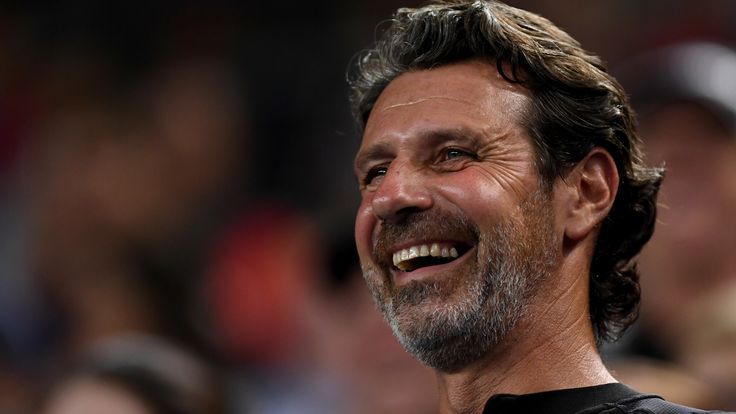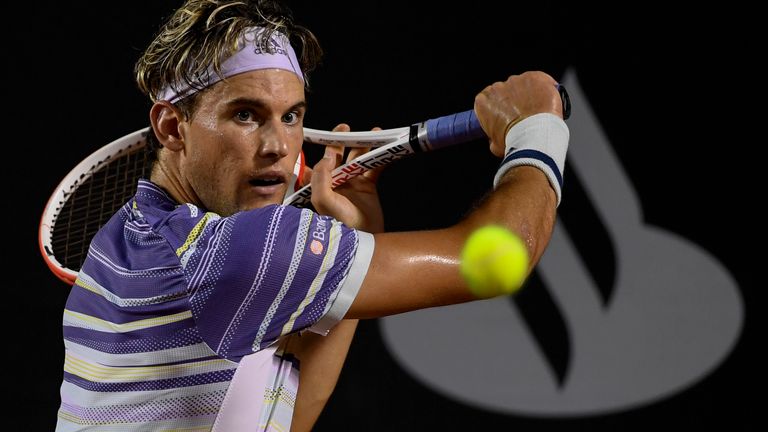Ultimate Tennis Showdown: Serena Williams' coach Patrick Mouratoglou debuts tennis brain-child
"The main reason is because I'm worrying for the future of tennis and it's something I've expressed many times publicly but also to the tennis industry people"

Tuesday 16 June 2020 16:25, UK
Patrick Mouratoglou has witnessed the success of T20 cricket alongside its traditional long format, and the rise of the Netflix series alongside multi-hour cinematic experiences.
With his Ultimate Tennis Showdown, he is striving to introduce a similar modernity to tennis to coincide with the ATP and WTA.
A first glimpse of the format's unconventional rules was put on hold on Saturday as rain saw the two days of matches pushed back to Sunday and Monday.
- 'Djokovic selfish over US Open comments'
- 'Men's tennis needs new champions'
- 'Tennis players face big prize reductions'
Once underway, Mouratoglou's league showcased the in-game interviews, coaching time-outs, unique scoring and player nicknames - such as the 'Underdog', 'Rebel' and 'Artist' - designed to attract new and younger fans.
Matteo Berrettini, Alexei Popyrin and Stefanos Tsitsipas were the only three men to finish the opening weekend with 100 per cent records after each winning their two matches, while Lucas Pouille, David Goffin and Dustin Brown remain winless.
Richard Gasquet, Benoit Paire, world No 208 Elliot Benchetrit, who was temporarily filling in for the absent Dominic Thiem, and Feliciano Lopez meanwhile each won one and lost one.
"Honestly, I liked it, it was nice. It's new," Gasquet told L'Equipe.
"The format was perfect. It was intense as it should be. It was fun, fun to play, really nice. Right now, there are no competitions, it's the best thing we can do. There is zero doubt. Excellent conditions, the Centre Court is beautiful.
"I can only dream of being here."
Mouratoglou, the coach of Serena Williams, plans to run UTS as a league alongside and without disrupting the current tennis calendar.
"The main reason (for creating UTS) is because I'm worrying for the future of tennis and it's something I've expressed many times publicly but also to the tennis industry people," Mouratoglou told reporters. "Quite a lot of people in the industry share a lot of thoughts about it.
"We have to worry for the future of tennis because the average age of the tennis fan is old, it's 61 years old and it's getting a year older every year. I tried to understand why we were in that situation.
"You have to realise that the fan base of tennis is the one that started to love tennis in the 70s and 80s and we keep that fan base which is great, fans are loyal which is not a surprise because our sport is fantastic and extremely addictive.
"But we're failing to renew it, we're failing to convince new people and especially young people to become tennis fans. I wanted to understand why."
UTS matches consist of four 10 minute quarters in which players take it in turns to serve two successive points, with sudden death available if the score is 2-2 after all four quarters.
There is a time limit of 15 seconds between points, while players have the opportunity to use 'UTS Cards' to give themselves an advantage. These include cutting an opponent's serve by one, increasing your own serve by one shot or winning more than one point on a clear winner.
Coaches are meanwhile able to use a buzzer to call a 30-second time-out to coach the players once in each quarter, which viewers are able to hear for the purposes of tactical insight. Mouratoglou admitted this is the UTS rule he would most like to see implemented in traditional tennis if given the choice of one.
The players each have a "purse" relating to their world ranking, starting at $5,000 all the way up to $30,000, with the winner taking 70 per cent and the loser 30 per cent from the combined pot.
Mouratoglou stresses that he doesn't want to change tennis and envisions UTS running alongside the ATP and WTA schedule as a means of expanding the sport's fan base.
In order to do so he believes in providing a platform to a range of styles, such as the "serve and volley" players, and the in-game player emotion he feels has been suppressed since the John McEnroe era.
"There was an initial promise in the 80s and I don't think this initial promise is still on today," he said. "Diversity, emotion, modernity.
"We had much more diversity in the 80s, more variety of game styles. No more young guns, much less and when there are young guns they have almost no chance to win a Grand Slam early because of restrictions for them.
"There was so much emotion before and there is much less now. It was so easy to identify ourselves with the top players before and they were sharing their emotions with us.
"They don't do it anymore, not so much and it affects the emotion in the matches. The top players are very protected in the Grand Slams so they basically win their matches very easily from the first round to the quarters, these are the matches you see in the big stadiums on prime time and there is no suspense."
UTS isn't the sport's first venture towards enhanced support, following on from the ATP's NextGen Finals which were aimed to unveil stars of the future.
"The whole goal is to improve and increase the fan base of tennis," he said. "Bring on new people who are not watching tennis yet or who are young and aren't interested in tennis."
Don't forget to follow us on skysports.com/tennis, our Twitter account @skysportstennis & Sky Sports - on the go! Available to download now on - iPhone & iPad and Android


